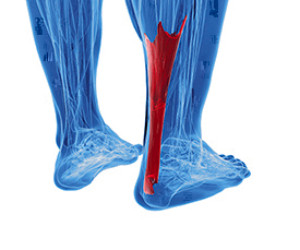Items filtered by date: May 2021
How the Achilles Tendon Can Be Injured
 The Achilles tendon is located on the back of the ankle and connects the heel to the calf muscles. The two most common injuries that affect the Achilles tendon are Achilles tendinopathy and an Achilles tendon tear or rupture. Achilles tendinopathy symptoms include swelling, stiffness, and pain that is more noticeable in the morning. An Achilles tendon tear or rupture is often the result of forceful jumping and pivoting and sudden accelerations that result in overstretching and the eventual tearing of the tendon. A complete rupture can cause severe pain and a loss of strength and movement. Because of the seriousness of an Achilles tendon injury, patients who are experiencing pain and swelling in this tendon should consult with a podiatrist. A podiatrist will be able to help provide preventative measures to avoid a rupture, as well as guide you in healing the injury.
The Achilles tendon is located on the back of the ankle and connects the heel to the calf muscles. The two most common injuries that affect the Achilles tendon are Achilles tendinopathy and an Achilles tendon tear or rupture. Achilles tendinopathy symptoms include swelling, stiffness, and pain that is more noticeable in the morning. An Achilles tendon tear or rupture is often the result of forceful jumping and pivoting and sudden accelerations that result in overstretching and the eventual tearing of the tendon. A complete rupture can cause severe pain and a loss of strength and movement. Because of the seriousness of an Achilles tendon injury, patients who are experiencing pain and swelling in this tendon should consult with a podiatrist. A podiatrist will be able to help provide preventative measures to avoid a rupture, as well as guide you in healing the injury.
Achilles tendon injuries need immediate attention to avoid future complications. If you have any concerns, contact Cory Brown, DPM of Cory Brown, DPM. Our doctor can provide the care you need to keep you pain-free and on your feet.
What Is the Achilles Tendon?
The Achilles tendon is a tendon that connects the lower leg muscles and calf to the heel of the foot. It is the strongest tendon in the human body and is essential for making movement possible. Because this tendon is such an integral part of the body, any injuries to it can create immense difficulties and should immediately be presented to a doctor.
What Are the Symptoms of an Achilles Tendon Injury?
There are various types of injuries that can affect the Achilles tendon. The two most common injuries are Achilles tendinitis and ruptures of the tendon.
Achilles Tendinitis Symptoms
- Inflammation
- Dull to severe pain
- Increased blood flow to the tendon
- Thickening of the tendon
Rupture Symptoms
- Extreme pain and swelling in the foot
- Total immobility
Treatment and Prevention
Achilles tendon injuries are diagnosed by a thorough physical evaluation, which can include an MRI. Treatment involves rest, physical therapy, and in some cases, surgery. However, various preventative measures can be taken to avoid these injuries, such as:
- Thorough stretching of the tendon before and after exercise
- Strengthening exercises like calf raises, squats, leg curls, leg extensions, leg raises, lunges, and leg presses
If you have any questions please feel free to contact our office located in Lewiston, ID . We offer the newest diagnostic tools and technology to treat your foot and ankle needs.
Different Types of Foot Pain in Runners
Runners can sometimes experience different types of foot pain after a run. Pain experienced in the heel or arch—especially in the morning—may be plantar fasciitis. Certain stretches and orthotics may provide some relief, however, if pain persists for more than a couple of weeks, a podiatrist may be able to heal the injury using a variety of therapies. Short-term relief from a bunion may be achieved by using bunion pads. A more lasting solution would be to have the bunion removed by a podiatrist who may also create custom orthotics to avoid bunions from returning. On the top of the foot, pain while running, swelling, or a bump on the tendon may be an indication of extensor tendonitis. Shoes that are too tight, or that create pressure on the top of the foot or are laced too tightly may make this situation worse. Proper stretching, icing, and anti-inflammatories may provide relief, along with professional treatments and custom orthotics. Pain relief from tendonitis along the side of the foot may be lessened by icing and resting, however since stress fractures also cause pain in this area, early detection and professional treatment by a podiatrist is suggested for proper diagnosis and treatment.
Exercising your feet regularly with the proper foot wear is a great way to prevent injuries and build strength. If you have any concerns about your feet, contact Cory Brown, DPM from Cory Brown, DPM. Our doctor can provide the care you need to keep you pain-free and on your feet.
Exercise for Your Feet
Exercise for your feet can help you gain strength, mobility and flexibility in your feet. They say that strengthening your feet can be just as rewarding as strengthening another part of the body. Your feet are very important, and we often forget about them in our daily tasks. But it is because of our feet that are we able to get going and do what we need to. For those of us fortunate enough to not have any foot problems, it is an important gesture to take care of them to ensure good health in the long run.
Some foot health exercises can include ankle pumps, tip-toeing, toe rises, lifting off the floor doing reps and sets, and flexing the toes. It is best to speak with Our doctor to determine an appropriate regimen for your needs. Everyone’s needs and bodies are different, and the activities required to maintain strength in the feet vary from individual to individual.
Once you get into a routine of doing regular exercise, you may notice a difference in your feet and how strong they may become.
If you have any questions, please feel free to contact our office located in Lewiston, ID . We offer the newest diagnostic and treatment technologies for all your foot care needs.
Causes and Preventative Methods for Cracked Heels
Cracked  heels are a common foot problem that can affect up to one in five adults. While cracked heels aren’t usually a big issue for most, they can lead to discomfort and severe pain. There are a variety of factors that can lead to cracked heels. These include standing for long periods of time, walking barefoot, using harsh soaps, dry skin from the climate, and shoes that don’t support the heels. Medical causes such as a vitamin deficiency, fungal infection, obesity, or pregnancy can also lead to cracked heels. In order to prevent cracked heels, make sure to wear shoes that properly support the heels by avoiding shoes with an open back, tall skinny heel, or shoes that are too tight. Staying hydrated, using a foot cream, avoiding standing in one place for a long period of time, and using custom shoe inserts are all ways to help prevent and treat cracked heels. If you have painful cracked heels, consulting with a podiatrist is suggested for a proper treatment method.
heels are a common foot problem that can affect up to one in five adults. While cracked heels aren’t usually a big issue for most, they can lead to discomfort and severe pain. There are a variety of factors that can lead to cracked heels. These include standing for long periods of time, walking barefoot, using harsh soaps, dry skin from the climate, and shoes that don’t support the heels. Medical causes such as a vitamin deficiency, fungal infection, obesity, or pregnancy can also lead to cracked heels. In order to prevent cracked heels, make sure to wear shoes that properly support the heels by avoiding shoes with an open back, tall skinny heel, or shoes that are too tight. Staying hydrated, using a foot cream, avoiding standing in one place for a long period of time, and using custom shoe inserts are all ways to help prevent and treat cracked heels. If you have painful cracked heels, consulting with a podiatrist is suggested for a proper treatment method.
Cracked heels are unsightly and can cause further damage to your shoes and feet. If you have any concerns, contact Cory Brown, DPM from Cory Brown, DPM. Our doctor can provide the care you need to keep you pain-free and on your feet.
Cracked Heels
Cracked heels appear unappealing and can make it harder for you walk around in sandals. Aside from looking unpleasant, cracked heels can also tear stockings, socks, and wear out your shoes. There are several methods to help restore a cracked heel and prevent further damage.
How Do You Get Them?
Dry skin is the number one culprit in creating cracked heels. Many athletes, walkers, joggers, and even swimmers suffer from cracked heels. Age and skin oil production play a role to getting cracked heels as well.
Promote Healing
Over the counter medicines can help, especially for those that need instant relief or who suffer from chronic dry feet.
Wear Socks – Wearing socks with medicated creams helps lock in moisture.
Moisturizers – Applying both day and night will help alleviate dryness which causes cracking.
Pumice Stones – These exfoliate and remove dead skin, which allows for smoother moisturizer application and better absorption into the skin.
Change in Diet
Eating healthy with a well-balanced diet will give the skin a fresh and radiant look. Your body responds to the kinds of food you ingest. Omega-3 fatty acids and zinc supplements can also revitalize skin tissue.
Most importantly, seek professional help if unsure how to proceed in treating cracked heels. A podiatrist will help you with any questions or information needed.
If you have any questions, please feel free to contact our office located in Lewiston, ID . We offer the newest diagnostic and treatment technologies for all your foot care needs.

